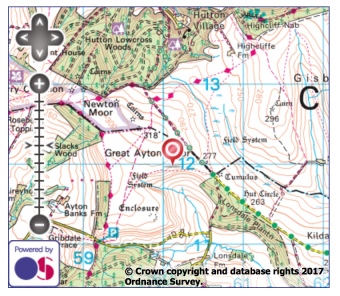A south facing offshoot of Kildale but draining into the River Tees. An evening view from Great Ayton Moor.

A south facing offshoot of Kildale but draining into the River Tees. An evening view from Great Ayton Moor.

I am quite opportunistic with my photography. I don’t usually have much of a plan, sometimes just a vague idea of a potential subject. Today overcast with very strong winds and rain threatening I wasn’t very hopeful. But as I skirted around Great Ayton Moor a break in the clouds threw Lonsdale below me in bright winter sunshine. Ahead is Percy Rigg with its Iron Age Village and Ernaldsti, perhaps the oldest track over the moors. On the right if you look closely are the lumps and bumps of Lonsdale Quarry where I was just four days ago under completely different conditions.
I’ve learnt a new word this week: coddiwomple, a verb meaning to travel purposefully toward an as-yet-unknown destination. That just about sums me up to a tee. Ninety per cent of the time the only plan I have is to get to the next decision point. That may be 100 yards or five miles away. And when I get there it’ll be a random decision to turn left or right. En route I’m apt to go off piste to chase a shaft of sunlight or to investigate a feature I’ve spotted on the map (I invariably run with a map in my hand even if a know the area, a map gives you so much information.)
A duvet of cloud covered the moors this morning. Even Roseberry kept its head under the covers for most of the morning. So there would be no chasing of shafts of sunlight today. I crested the escarpment in deepening gloom and it was only then I remembered this birch tree in an old quarry overlooking Lonsdale. A tree I had thought would make a good subject. Decision made, I headed into the mist across Great Ayton Moor.
Birch is a graceful, resilient tree, equally at home on the Russian steppes as growing out of a vertical sandstone rock face. Its bark has been used as water resistant paper and in tanning and birch leaf tea is an antiseptic. In mythology it is believed to drive out evil. Perhaps that’s why birching was a corporal punishment. More pleasant is the tradition of birch cradles to protect new-born babies from evil spirits and if a barren cow was herded with a birch stick the calf would be fertile; and if she was pregnant the calf would be healthy.
Astute readers will notice I’ve changed the colour scheme for this blog. A new year, a new theme.
The striking red berries of the Rowan tree stand out against the drab Autumn colours of the moors. The Rowan or Mountain Ash has long been associated with superstition and folklore. In Greek myology the goddess of youth, Hebe, lost her cup of ambrosia, said to rejuvenate youth. It was stolen by demons and the gods sent an eagle to retrieve it. In its fight with the demons the eagle lost blood and where every drop fell to earth a rowan tree grew. In Norse mythology the first woman was made from the Rowan. In Britain the Rowan is supposed to give protection against witchcraft and evil spirits, often planted near houses and churches. Cutting down a Rowan tree is considered bad luck although a spoon made of the wood prevented milk from curdling and a piece of the wood would be carried as charm against evil and to cure rheumatism. But the wood would have to be cut to make the spoon.
The ironstone mine at Lonsdale is another example of the feeding frenzy that followed the discovery of ironstone in the Eston Hills in the 1850s. And as with the Warren Moor Mine it was a royalty let by the Kildale Estate which failed to live up to expectations. The main man is again John Watson, a Fellow of the Geological Society from Essex. who must have had powers of persuasion to match Arthur Daley. In 1865 he leased the whole of the royalties of the Kildale Estate and persuaded his wealthy London friends to invest in ironstone. Together they formed the Lonsdale Vale Ironstone Mine which sub-leased the 2,000 acre royalty in Lonsdale from Watson.
So far so good. A shaft was sunk to reach the Main Seam, 145′ deep. Plans were made to built a furnace in the valley. But the quality of the ironstone again was poor. It is doubtful if any ore from the Main Seam was actually gained. A small drift mine half a mile to the south east into the outcropping Dogger seam did produce almost 48,000 tons but by 1868 the Kildale Estate was owed a year’s rent and forced the company into liquidation.
The stone arch of the engine house is the most visible reminder of ironstone mining Lonsdale. The outlines of other buildings and the railway extension can be traced in the fields beyond the arch.
You must be logged in to post a comment.